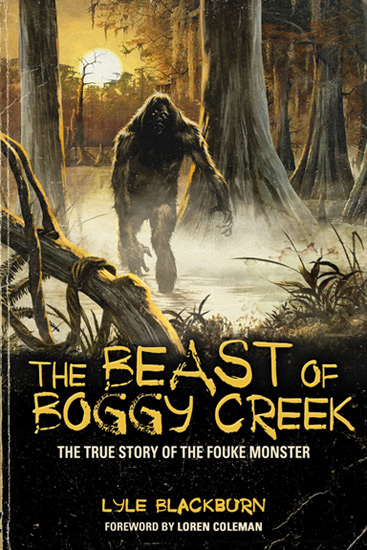
Growing up in Ohio during the “formative” years of North American Bigfoot knowledge–the Yeti expeditions of the 1950s and 1960s, the Jerry Crew California tracks of 1959, and the Patterson-Gimlin film of 1967—the Bigfoot phenomenon was to me a distant beacon, tantalizing, but far away. I had just graduated from college and entered my working life when I saw the movie The Legend of Boggy Creek in late 1972. It became a watershed event for me because, as a “true” story, it brought Bigfoot out of the far away Pacific Northwest and into the heart of America. And if the beast was found in a little bottomlands town like Fouke, Arkansas, it might be elsewhere across the country, and it might be closer to me than I thought possible, further piquing my already significant interest in the subject and leading me to pursue it later in life. Now in 2012, another defining moment has arrived on the subject of Boggy Creek and its big-screen monster. Lyle Blackburn’s definitive book, The Beast of Boggy Creek: The True Story of the Fouke Monster (2012, Trade Paperback / Anomalist Books), is such a watershed moment in that he has brought to life the history behind the beast that terrorized Fouke and the surrounding towns in the well-publicized encounters of 1971 that led to the movie The Legend of Boggy Creek.
Blackburn’s book is both informative and entertaining, written in a style that is easy to read and sequenced in an order that follows our logical thought process about the Fouke creature and the resulting movie and answers all the important questions a reader might ask – “Was there a history of sightings before the movie? Did the events in the movie really happen? How did the movie get made? What happened to the creature since the movie? Is it still there? Was it the same type of creature throughout the sightings? What was the real evidence? Who is Smokey Crabtree and what was his role in this?” The research behind this book is extensive and encompassed years of investigation and interviews in the Fouke area, providing a top-rate journalistic viewpoint on the phenomenon and the movie.
The Beast of Boggy Creek’s excellent reading material is supplemented by maps of the Fouke area and the bottomlands of the Sulphur River and Boggy Creek, wonderful sighting illustrations by Dan Brereton, and an extensive number of photographs, including many from the Miller County Historical Society. The appended materials include both a chronological sightings database and the movie scene by scene database with the corresponding real-life sighting descriptions. A comprehensive bibliography also provides a wealth of research materials into the history of encounters with the Fouke Monster and the region’s rich history of sightings.
The Sulphur River Bottoms and its various tributaries, like Boggy Creek and others, have provided a wealth of Bigfoot creature sightings in its three-state (Texas, Arkansas, and Louisiana), rain- and wildlife-rich environment. It is the perfect location to hide such a creature, with vast areas of impenetrable swamplands, thick vegetation, scant human populations, linked river systems, and temperate weather conditions for the most part. In short, it is a highly sustainable habitat for such a creature. Our TBRC sightings database provides an accurate window into that environment and the Boggy Creek creature in the numerous sighting reports from the Sulphur River area, several of which are detailed to great effect in Blackburn’s book. In addition to his accurate and comprehensive descriptions of the physical setting of the Fouke Monster’s habitat, Blackburn brings to life the true spookiness and isolation of the swampy bottomlands, something anyone who has been there can appreciate and something that was a major factor in the popularity of the movie, inspiring that drive-in movie monster kind of fear.
The book’s treatment of its centerpiece—The Legend of Boggy Creek movie—is, by itself, more than ample reason to buy this book. Blackburn richly conveys how a whirlwind of publicity around the Fouke sightings in 1971 created a demand to know more about the creature and Fouke; how that demand led a fledging movie maker, Charles B. Pierce, to leave his advertising career in Texarkana to make his first of many movies; how a shoestring budget forced Pierce to use local Fouke-area people to reprise their own encounters at the actual sites in some cases and to portray their neighbors in other cases; and, how that same shoestring budget forced Pierce to adopt a handheld camera filming approach, a more documentary style. All of these factors, Blackburn concludes, created a perfect storm of a movie that appealed to many on a visceral level, generating both fear and attraction. Blackburn’s interviews with those involved with the movie and the film-maker, including Pierce’s daughter, flesh out what we want to know about the how the movie was made and why it was made the way it was. One important example of that is Blackburn’s exposition of the Crabtree family’s role in the creature sighting saga and the movie, both in front of and behind the camera. Smokey’s son Lynn and his sighting were portrayed by the other Crabtree son Travis, making him the character we knew in the movie. Smokey Crabtree was enlisted as a shooting guide for the area and became the informal liaison between Pierce and the residents of the Fouke area. Later Smokey would become the focal point of some animosity the locals had for Pierce when they did not receive, according to the author, any monetary benefit from the film when it hit big. From a regional low-budget ($100,000) movie that only was seen at first because Pierce rented the theatre to show it in, the film eventually grossed $25 million; this book provides an entertaining behind-the-scenes look at that process.
The film’s climax and focal point, the repeated encounters at the Ford house, are detailed in the book and fact is separated from movie fiction, the latter of which is a whole lot less than you might imagine. This and other actual sightings, both those portrayed in the movie and those not, are brought out in the book in excellent journalistic style (and never dry) with supporting interviews and other background materials.
Blackburn provides a lot of great material on sightings and encounters reported in years after the movie in the immediate area and the region. He also details the impact of the film’s success on the Fouke area locals and the trouble it caused, from the large influx of bothersome monster hunters trampling property to the tension among the locals regarding the film itself. His documenting of contemporary research efforts of organizations such as the TBRC, the continuation of sightings to the present day, and the solid nature of such sightings (presented in vivid detail), lead the reader to the conclusion that an unknown man-like creature is alive and well in the Sulphur River basin.
As to the nature of the beast itself and the curious three-toed tracks associated with this creature, Blackburn discusses and effectively disproves the many theories given about the monster: that it was an escaped circus ape, an invention of moonshiners to keep people away from their stills, a racist town’s means of keeping the area segregated, a hoax, or a panther. We are left then with the concept that this could be a “hidden hominoid” as Blackburn puts it, perhaps a Bigfoot cousin of “Patty” (the film subject in the Patterson-Gimlin film). Then, if real, we are left to answer the question of the three-toed tracks, which Blackburn investigates in a subchapter, entitled “Trouble with Three Toes.”
The Beast of Boggy Creek is, besides being a first-rate piece of journalism regarding this unknown creature and the movie inspired by it, the comprehensive reference to the Fouke Monster and a thoroughly entertaining read, suspenseful and intriguing. Like the improbable movie that ignited many of us to actively research the Bigfoot phenomenon, Blackburn’s book should serve to jump-start this kind of journalistic research in the Bigfoot community. The Beast of Boggy Creek is a must-read for the serious researcher, the fan of The Legend of Boggy Creek movie, and the Bigfoot enthusiast.
You can pick up your own copy of The Beast of Boggy Creek here.
